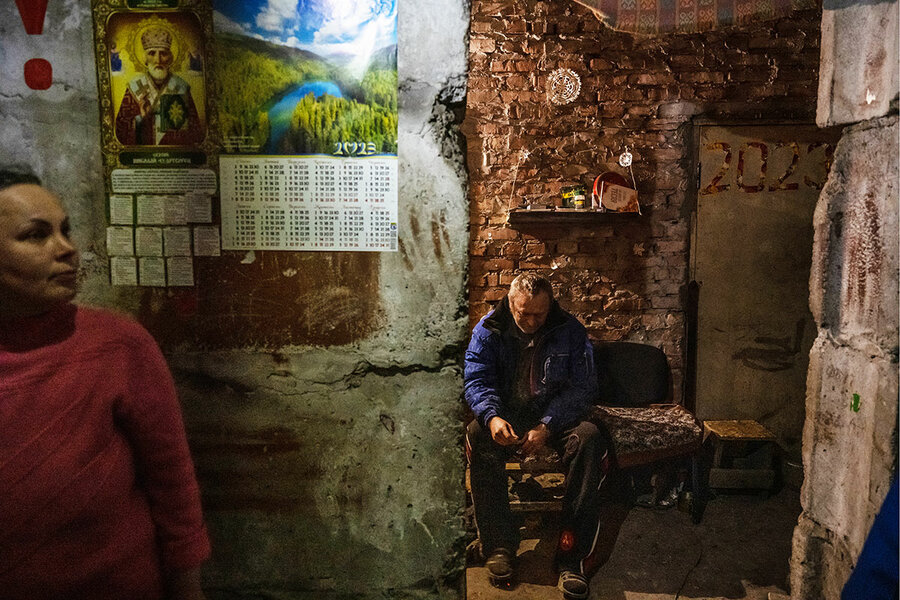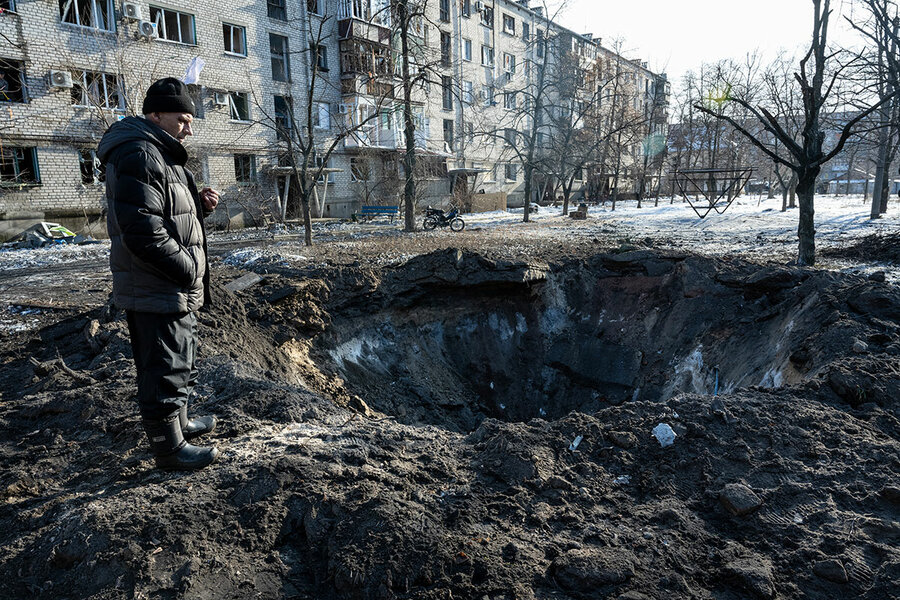Safe space: In liberated Lyman, dank but familiar cellar is still home
Loading...
| LYMAN, Ukraine
During the months that Russian forces occupied the Ukrainian village of Lyman, up to 60 people lived underground in this musty basement of a Soviet-era apartment block, cooking on gas cylinders, lining walls with split wood for heating, and stringing up lights for moments of electricity.
Ukrainian troops liberated Lyman more than four months ago. But living underground has become a hard habit to break, especially with the front lines no more than a few miles away and Russia regularly targeting the area with artillery and rocket fire, lending a steady soundtrack of ominous explosions.
Why We Wrote This
A story focused onRussian forces were driven from the Ukrainian village of Lyman months ago, but the fighting is still too close, and damage too extensive, to give many residents the confidence to return to their homes. They are finding security, and community, underground.
Some 24 people – including a teenage girl, whose New Year decorations taped to the concrete walls continue to raise spirits – still reside in the makeshift bunker. They are torn between their relatively safe but severely constricted life lived underground, and the freedom that beckons on the surface above.
“If we knew there was a light at the end of the tunnel, it would be better,” says a basement resident who gives the name Yana. “Now we go to bed each night, worried that a missile will come. It feels safer underground, but it’s still bad when your whole house is trembling above you.”
The underground basement of the Soviet-era apartment block was never meant for human habitation. At the bottom of a dingy flight of stairs, the decades-old storage area has narrow, musty corridors, unwelcoming concrete cells hung with metal doors, and an uneven dirt floor.
But when Russian invasion forces seized this town in northeast Ukraine last May – accompanied by weeks of bombardment that wrecked houses and endangered lives above ground – residents raced to the tight confines of this bunker-like sanctuary.
In the coming months of Russian occupation, up to 60 people lived down below in the fusty air, cooking on gas cylinders, lining walls with split wood for heating, and stringing up lights for moments of electricity.
Why We Wrote This
A story focused onRussian forces were driven from the Ukrainian village of Lyman months ago, but the fighting is still too close, and damage too extensive, to give many residents the confidence to return to their homes. They are finding security, and community, underground.
Ukrainian troops liberated Lyman more than four months ago. But living underground has become a hard habit to break, especially with the front lines no more than a few miles away and Russia regularly targeting the area with artillery and rocket fire, lending a steady soundtrack of ominous explosions.
“Of course, we feel so tired, and apathy comes,” says Iryna Dmytrenko, the head of the residents here, who boils water in a makeshift kitchen as the rumble of a tank penetrates from above.
“We ask, ‘How long can you hide, and sit here and be afraid?’” says Ms. Dmytrenko. “We had that feeling before, but now it comes back more and more often.”
Some 24 people – including a teenage girl, whose New Year decorations taped to the concrete walls continue to raise spirits – still reside in the makeshift bunker.
They say their sense of community has grown more than they thought possible before the Russian invasion, just over a year ago. Living so closely together, they have demonstrated to each other a reassuring “reliability of neighbors,” says Ms. Dmytrenko.
The dynamic is replicated across Ukraine, especially in areas liberated from Russian occupation, where a communal cohesion has grown even as a year of gnawing conflict has made returning to prewar normal life a challenge.
In this Lyman basement even the dog, named Diana, is concussed by the amount of shelling she has experienced, say those who dwell here.
And they have good reason to stay below: Just hours before a recent visit, for example, a Russian rocket landed a few blocks away, leaving a large crater in a residential courtyard and damaging scores of apartments.
That is on top of the now steady nuisance of melting snow and rain leaking into war-damaged apartments, which residents say makes anything but modest repairs – never mind moving back home – pointless before spring.
“If we knew there was a light at the end of the tunnel, it would be better,” says another basement resident, who gives the name Yana. “Now we go to bed each night, worried that a missile will come. It feels safer underground, but it’s still bad when your whole house is trembling above you.”
Those living in this basement, and many others in Lyman, rely on charitable organizations for food and hygiene kits. The railway – once the lifeblood of this crossroads town, and a big employer – is not yet working again, because of damage to the lines, and proximity to the fighting.
And that has also slowed down rebuilding efforts. Residents say Western aid groups that specialize in wholesale rebuilding visited for a survey, but told them they could do nothing unless the front lines were at least 40-plus miles distant – seven times further away than they are.
Filling the gap with emergency supplies are Ukrainian citizens, who flooded to this northeastern Kharkiv region after a lightning counteroffensive last fall pushed Russian troops back from swaths of occupied territory.
“What amazed me the most was that people would come [to help] from Bucha, from Borodyanka and Irpin, because they know what it is like to go through this,” says Ms. Dmytrenko, referring to northwestern Kyiv districts where retreating Russian occupation forces left behind a trail of brutal killings and destruction early in the war.
“It’s very bad that people, children especially, have to go through this. We start at the smallest sound, if the dog barks. There was so much stress,” says Ms. Dmytrenko. “Citizens’ organizations are offering their help – we can’t complain.”
Still, the result today is a town in limbo, with citizens torn between their relatively safe but severely constricted life lived underground, and the freedom that beckons on the surface above, where Ukrainian officials back in control since October have struggled to provide services.
“Most people were happy that Ukrainian forces came back, but people were disoriented,” says Oleksandr Zhuravliov, the mayor of Lyman, who worked outside the town, along with the rest of the original Ukrainian administration, during the months of Russian occupation.
Asked about pro-Russian sympathies among some residents, he says most people “want to live under the rule of law.”
“A lot of people now know what is the ‘Russian World.’ They felt it,” says the mayor, referring to Moscow’s stated ambition to absorb Ukraine into a broader, pro-Russian empire based on Russian culture and language.
The greater Lyman district includes 40 different villages and towns, with levels of destruction as high as 90%. The initial plan was to restore electricity and gas within three months, “but the war is so close, it will take time,” says Mr. Zhuravliov.
He describes how electrical repairs have been short-circuited by shrapnel stuck in cables, and how gas pipes, too, have been pierced by tiny pieces of shrapnel, making them difficult to seal. Municipal workers, rather than focusing on the large-scale rebuilding of infrastructure, form teams to cover roofs to minimize water damage.
Up to 10% of the former residents who left have returned, with more promising to come home in the spring.
On his phone, the mayor shares videos of himself evacuating citizens as the Russians approached. He also shows pictures of his farm and his horse, which he says was shot dead by Russian troops, along with his dog.
Mayor Zhuravliov puts his head in his hands when told of a Lyman resident fervently trying to convince people passing by the crater formed by the missile the previous night that it was a Ukrainian missile fired into the residential area, and not one from Russia.
“There are categories of people who are waiting for Lenin, who are waiting for [Soviet leader Leonid] Brezhnev,” says Mr. Zhuravliov. “I don’t know where they get this information. First, we try to change this [pro-Russian] mood by the real deeds of what we do. We provide food and medical supplies, candles, clothes.
“And we explain: ‘Before Feb. 24, you had everything, electricity, internet, a gas connection,’” he says. “‘You had it, and it was all taken from you. Before Feb. 24, no one was shooting at you from Ukraine, right?’”
For those living in the basement, one reminder of their uncertain prospects lies directly above: their shrapnel-scarred building, missing most its windows since the first Russian missile fired at Lyman landed just a few yards away, across the courtyard, last April 25.
“Of course we are concerned; we are just sitting here and listening to what is going on,” says Yuri, who wears the uniform of a railway worker, during an upstairs break for fresh air. “Sometimes it’s quiet. Sometimes it’s loud. It’s hard to understand.”
Oleksandr Naselenko supported reporting for this story.












